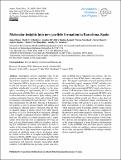Por favor, use este identificador para citar o enlazar a este item:
http://hdl.handle.net/10261/231048COMPARTIR / EXPORTAR:
 SHARE SHARE
 CORE
BASE CORE
BASE
|
|
| Visualizar otros formatos: MARC | Dublin Core | RDF | ORE | MODS | METS | DIDL | DATACITE | |

| Título: | Molecular insights into new particle formation in Barcelona, Spain |
Autor: | Brean, James; Beddows, D.C.S.; Shi, Zongbo; Temime-Roussel, B.; Marchand, N.; Querol, Xavier CSIC ORCID ; Alastuey, Andrés CSIC ORCID; Minguillón, María Cruz CSIC ORCID ; Harrison, Roy M. | Fecha de publicación: | 2020 | Editor: | European Geophysical Society | Citación: | Atmospheric Chemistry and Physics 20: 10029- 10045 (2020) | Resumen: | Atmospheric aerosols contribute some of the greatest uncertainties to estimates of global radiative forcing and have significant effects on human health. New particle formation (NPF) is the process by which new aerosols of sub-2 nm diameter form from gas-phase precursors and contributes significantly to particle numbers in the atmosphere, accounting for approximately 50 % of cloud condensation nuclei globally. Here, we study summertime NPF in urban Barcelona in north-eastern Spain utilising particle counting instruments down to 1.9 nm and a Nitrate Chemical Ionisation Atmospheric Pressure interface Time of Flight Mass Spectrometer (CI-APi-ToF). The rate of formation of new particles is seen to increase linearly with sulfuric acid concentration, although particle formation rates fall short of chamber studies of <span classCombining double low line"inline-formula">H2SO4</span>-DMA-<span classCombining double low line"inline-formula">H2O</span> while exceeding those of <span classCombining double low line"inline-formula">H2SO4</span>-BioOxOrg-<span classCombining double low line"inline-formula">H2O</span> nucleation, although a role of highly oxygenated molecules (HOMs) cannot be ruled out. The sulfuric acid dimer : monomer ratio is significantly lower than that seen in experiments involving sulfuric acid and dimethylamine (DMA) in chambers, indicating that stabilisation of sulfuric acid clusters by bases is weaker in this dataset than in chambers, either due to rapid evaporation due to high summertime temperatures or limited pools of stabilising amines. Such a mechanism cannot be verified in these data, as no higher-order <span classCombining double low line"inline-formula">H2SO4</span>-amine clusters nor <span classCombining double low line"inline-formula">H2SO4</span>-HOM clusters were measured. The high concentrations of HOMs arise from isoprene, alkylbenzene, monoterpene and polycyclic aromatic hydrocarbon (PAH) oxidation, with alkylbenzenes providing greater concentrations of HOMs due to significant local sources. The concentration of these HOMs shows a dependence on temperature. The organic compounds measured primarily fall into the semivolatile organic compound (SVOC) volatility class arising from alkylbenzene and isoprene oxidation. Low-volatility organic compounds (LVOCs) largely arise from oxidation of alkylbenzenes, PAHs and monoterpenes, whereas extremely low-volatility organic compounds (ELVOCs) arise from primarily PAH and monoterpene oxidation. New particle formation without growth past 10 nm is also observed, and on these days oxygenated organic concentrations are lower than on days with growth by a factor of 1.6, and thus high concentrations of low-volatility oxygenated organics which primarily derive from traffic-emitted volatile organic compounds (VOCs) appear to be a necessary condition for the growth of newly formed particles in Barcelona. These results are consistent with prior observations of new particle formation from sulfuric acid-amine reactions in both chambers and the real atmosphere and are likely representative of the urban background of many European Mediterranean cities. A role for HOMs in the nucleation process cannot be confirmed or ruled out, and there is strong circumstantial evidence of the participation of HOMs across multiple volatility classes in particle growth. | Versión del editor: | http://dx.doi.org/10.5194/acp-20-10029-2020 | URI: | http://hdl.handle.net/10261/231048 | DOI: | 10.5194/acp-20-10029-2020 | Identificadores: | doi: 10.5194/acp-20-10029-2020 issn: 1680-7324 |
| Aparece en las colecciones: | (IDAEA) Artículos |
Ficheros en este ítem:
| Fichero | Descripción | Tamaño | Formato | |
|---|---|---|---|---|
| acp-20-10029-2020.pdf | 6,64 MB | Adobe PDF |  Visualizar/Abrir |
CORE Recommender
Page view(s)
76
checked on 19-abr-2024
Download(s)
87
checked on 19-abr-2024
Google ScholarTM
Check
Altmetric
Altmetric
NOTA: Los ítems de Digital.CSIC están protegidos por copyright, con todos los derechos reservados, a menos que se indique lo contrario.
